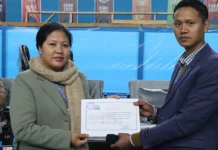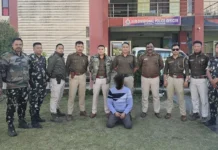Staff Reporter
DEHRADUN, 1 Dec: The Integrated Mountain Initiative (IMI) has called for adopting disaster management strategies by using an ‘integrated landscape approach’ that combines appropriate land use planning based on risk assessment and vulnerability, “along with participatory management of non-climatic aspects.”
The IMI drew the attention of all stakeholders to the vulnerability of the Himalayan landscape to disasters, causing loss of human lives, displacement, and serious damage to mountain ecosystems, during the two-day 6th World Congress on Disaster Management, held at the Graphic Era University here in Uttarakhand on Friday.
A session themed ‘Voices from grassroots’ brought together a plethora of stakeholders, led by the local
community, champions of best practices, development practitioners, scientists, and NGOs with decades of experience in the region, with the aim of conducting an ‘authentic policy and practice’ which can contribute to disaster risk reduction and management.
“The Indian Himalayan region needs mountain development-specific policy that is built on multi-stakeholder consultation, and incorporate landscape needs and perspectives while learning from traditional knowledge,” the IMI stated in a release.
It said that it has “apprised the government and the stakeholders of the need to improve the current capacity-building designs on disaster risk reduction and its management (awareness and preparedness aspects) by considering the needs and perspectives of local communities and other stakeholders whose education and training is relevant for building local resilience and response capabilities during disasters.”
It also advocated adopting cost-effective nature-based solutions “for prevention and proactive response to disaster risks,” emphasising on “sustainable use of natural systems, such as natural regeneration of forests, wetland restoration and agriculture practices as effective means of resilience-building through non-climatic factors, thus minimising occurrence of disasters in the future.”
It further stressed on strengthening and expanding early warning systems; utilising both technology and community-based communication channels to ensure on-time and effective alerts; and fostering collaborations between government agencies, NGOs, and local communities to create a comprehensive and coordinated approach towards disaster management.
The session also highlighted “the obvious frequency of disasters that are now striking the entire Himalayan landscape, causing frightening loss of life, economic strife and human displacement, apart from the serious damage to the mountain ecosystems, reducing their capacity and quality in providing ecosystem services,” the IMI said, and amplified the “advantage of traditional practices and knowledge reinforced by social collectivism, thus displaying the inherent capacity of the local communities and institutions to be resilient to disasters.”
The session was attended by representatives of the IMI governing council, led by IMI president Ramesh Negi. Dr Rajan Kotru, Dr Jigmet Takpa (IMI) and Dr Arun Shrestha (ICIMOD) also spoke.




